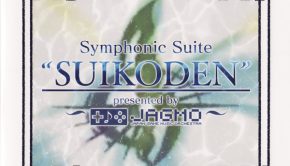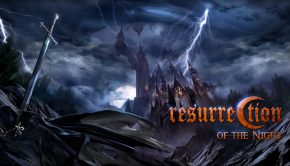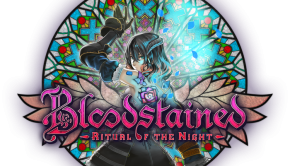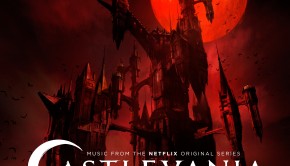Michiru Yamane Interview: The Musical Legacy of Castlevania
 Michiru Yamane is a much-loved composer known for her work on the Castlevania series. She has composed for ten of the series’ titles to date, ranging from the classic Bloodlines to the much-loved Symphony of the Night to the more recent Order of Ecclesia, introducing new gothic and rock elements to the series with each instalment.
Michiru Yamane is a much-loved composer known for her work on the Castlevania series. She has composed for ten of the series’ titles to date, ranging from the classic Bloodlines to the much-loved Symphony of the Night to the more recent Order of Ecclesia, introducing new gothic and rock elements to the series with each instalment.
In her most definitive interview so far, Michiru Yamane takes us on a tour of her career. She reflects on her musical legacy for the Castlevania series now she has left Konami. She also discusses her works outside the series, ranging from debut roles on shooters, to RPG contributions such as Suikoden, through to even appearances on sports games. Finally, she provides an insight into her more recent works, including her arrangements for the Guwange album release and the Castlevania series’ box set.
Interview Credits
Interview Subject: Michiru Yamane
Interviewer: Chris Greening
Editor: Chris Greening
Translation & Localisation: Shota Nakama
Coordination: Chris Greening
Interview Content
Chris: Michiru Yamane, thank you for speaking to us today. First of all, could you discuss your general background and musical influences? What led to you becoming a game composer at Konami?
Michiru Yamane: I started taking lessons for the piano and electronic organ since I was little, and I also started composing music when I was around eight years old. I majored in composition at a college, and I was introduced to sequencing music on a computer while at graduate school.
My influences are traditional classical music in general (Bach, Mozart, Beethoven, Chopin, Rachmaninoff, Ravel, Debussy), Kraftwerk, techno-pop artists like Yellow Magic Orchestra, and various jazz, rock, and bossa-nova artists. In addition, I was really attracted by the music of Ryuichi Sakamoto when I was in my middle school and high school. After I started working, I think I was influenced by progressive rock like Dream Theater, ethnic music, film scores, and contemporary classical music.
When I was about to graduate, I joined a company where I can work full-time composing music to earn money, which happened to be a game company. I worked there for 20 years, and as a result, now I am recognized as a game composer.

Chris: Before moving on to your Castlevania works, it’d be fascinating to hear you reminisce about your early experiences at Konami. What was it like to work within the Konami Kukeiha Club during this period? Was it enjoyable or restricting to work on projects mainly as a team?
Michiru Yamane: I learned big orchestration techniques to express music back in my college. When I joined Konami, I therefore felt very limited having to compose with only three simultaneous notes for NES. However, as I kept working, I started having fun working around such a limitation.
There is this collection of pieces called “Inventions and Symphonias” composed by J.S. Bach, and he made all the beautiful pieces with full of architectural beauty by using only two or three simultaneous notes. This was a particular motivation for me. Every day it was a challenge to create game music effectively and often I struggled with the limitation, yet there was a sense of accomplishment. When I composed something good, I felt like I cooked delicious food with a small budget.
Chris: Some of your first projects were shooter scores, namely Gofer no Yabou Episode II, Nemesis, and Detana!! Twinbee. What were the musical expectations for these projects? Were these works a good introduction to the so-called ‘Konami Sound’?
Michiru Yamane: Yes, exactly. Those are all deep in my memory. I learned so much from the works at the time and I think that built the foundation for me as a game composer.
To me, shooting games are all about flying around to beat the objects. While doing so, you hear nice, satisfying sound effects while cool music is streaming on the background… In a way, it is a strongly synchronized world like Disney movies, in that all the characters are totally in synch with the sounds. In terms of creating the desired atmosphere, I created some cool and spacey music for Gofer no Yabou Episode II and Nemesis. On the other hand, I made very colorful and fun music for Detana!! Twinbee in order to match the cute bee world.
Chris: You also contributed to other popular franchises, including Goemon, Contra, and Sparkster. Could you discuss what it was like working on these franchises and what music you offered to each of these scores?
Michiru Yamane: Goemon 2 was the first game I worked on as a main composer in the year I joined Konami. I learned a lot about editing techniques for PSG samples from my seniors. For the music, I was aiming on making something that the players can enjoy while playing the game. As a result, I went for comical Japanese-influenced sound to match the background of the game, which is set in the Edo era of Japan.
As for Contra…. is it on the NES? To be honest, I do not remember composing for this game. When I go overseas, some fans bring Contra CDs along with some Castlevania CDs for autograph sessions. Maybe my name is credited on it. The sound team was probably really busy back then, so I might have contributed one or two pieces to help out. I remember Konami developing Contra on NES and SNES, but I really do not remember if I was involved in its development. [Editor’s Note: A pseudonym of Michiru Yamane is credited as composing some of the Genesis’ Contra: Hard Corps]

Sparkster was being developed for Genesis and SNES simultaneously. I composed for the SNES title and I think I made the sound effects for the Genesis one as well. If I remember correctly, we were going for SEGA’s mega-hit game direction, so I created poppy and groovy music with some exciting rhythms. At the time Akira Yamaoka, who later took charge of Silent Hill music, joined the company and I think we worked on the Genesis version of Sparkster together. He was already amazingly talented and stood out from the others for sequencing. I think I did a good job on that game because of the inspiration I got from working with such a person.
Chris: Nevertheless, your popular breakthrough was probably Castlevania: Bloodlines. What were the main musical and technological challenges of this project? How did you retain the series’ trademark sound while adding your own individuality?
Michiru Yamane: First of all, I think there was some affinity between the image of a vampire-infested world with the traditional classical music that I had been taught from a young age. Back then, I thought very carefully and tried integrating such things as the classical music element that had already been a part of me with the rock elements previously featured in the series. In addition, dynamic bass lines and groovy rhythms were fundamental to the game’s music.
In addition, some great musical works already existed from the previous Castlevania games and I gained inspiration from tracks such as “Vampire Killer”, “Beginning”, and “Bloody Tears” especially, which have become the standard tunes for the series now. There were many heritages like these that the previous composers had left for me. I analysed the compositions to find out the secret of their charm and composed so I didn’t create something inferior to previous works.
Chris: You developed the series’ sound further on Castlevania: Symphony of the Night. What do you think made this soundtrack so iconic with fans? Do you agree with the masses that it is your best Castlevania score?
Michiru Yamane: Firstly, for Symphony of the Night, the PlayStation was significantly superior to the Genesis, so the capacity to express the music and the graphics expanded dramatically. Thus, we could no longer blame limitations in musical quality on the performance and capacity of the hardware. That made me work under further pressure, although I was really happy to be able to have a broader range of musical expression at the time.
Another thing that I cannot forget to mention is that I encountered the illustration of Ayami Kojima for the title. Thinking about the meeting now, her works gave me a major inspiration and influenced me hugely. I was able to compose the music that matched with the beautiful background graphics of the whole game.
I am not sure if this is the best work of mine because that is up for people to decide, but I am very happy if it is. Even now it is picked up and listened to by many people. I think that is because the game contains so much effort of the team and me — it reflects their passion and joy for the game development, even though it was rough.

Chris: You developed the series’ music further with Castlevania: Curse of Darkness and Castlevania: Lament of Innocence. What inspired the contrasting approaches and expansive compositions of these titles?
Michiru Yamane: For Lament of Innocence, the game shifted to 3D and the system was changed remarkably. At the initial stage of the development, we were going for the trend of the time of incorporating a huge map to explore. I tried to accommodate this expansive approach by creating a lot of ambient and drone music, some of which incorporated sound effects. However, the developers couldn’t really change the style of a game entirely and they eventually changed the specifications back to the stage-based format. I then made a lot of catchy melodies and groovy rhythm patterns to complement the new direction of the game.
For Curse of Darkness, we did not experience such an advancement in the console like we did for Symphony of the Night and Lament of Innocence. It was really difficult to figure out how to approach the music because the game’s world and system did not change as much. However, getting enough budget to have an actual singer [Editor’s Note: The People’s Tenor Russell Watson] really encouraged me. Listening back to the soundtrack now, it really reminds me how I was struggling with making the music at the time.
Chris: Over the years, you’ve also been involved with the portable instalments for the Castlevania series. How does composing for the GBA and DS scores compare with the home console scores? Which of these scores are you most proud of and why?
Michiru Yamane: Working on the GBA and DS felt like going back to the previous generation. I thought it was hard having a limitation for the memory capacity and the number of notes again, but just like the old days, I was really happy when I was able to put in the music to the console well. These handheld consoles are in between the Genesis and PlayStation 2 in terms of the performance, and it was fun working on them.
For the handheld consoles, Aria of Sorrow, Portrait of Ruin, and Order of Ecclesia are my favorites. Portrait of Ruin became an especially memorable title for me due to working with Yuzo Koshiro. Another reason was the release of its soundtrack that included the game version and the original version of the music. The wish for the people to listen to the music with the best sound quality is the universal desire of the ones who give musical expressions.
Chris: Your latest Castlevania score was Castlevania: Order of Ecclesia. Could you discuss what inspired your diverse approach to this soundtrack? Did you compose it with the intention of it being your last Castlevania score?
Michiru Yamane: For this title, the sound director Yasuhiro Ichihashi-san brought me various music samples to support me. He also wrote some music for the game, and I think that gave a good contrast with what I composed. I am not sure if I remember correctly, but I think I sometimes thought “this might be the last work at Konami….” during the game’s development.

Chris: Moving away from Castlevania for a while, you’ve also participated in the scores for two other RPGs, Suikoden III and Suikoden IV. Given you are the last-credited composer for these scores, could you outline how large your role was and what themes you were responsible for? How did it feel to inherit Miki Higashino’s legacy on these projects?
Michiru Yamane: My role for Suikoden III was more or less as a contributor, considering I only created 14 pieces out of a total of 76 pieces. I just pulled out the soundtrack now to listen, and luckily I found a memo for the ones I was in charge of. To be specific, they are tracks 10, 11, 14, 15, 27, 31, 37, and 42 on Disc One and tracks 4, 15, 22, 25, 27, and 28 on Disc Two.
Unfortunately, I do not have a memo for Suikoden IV. Listening back to it now, I think I handled the composition of track 10 and the arrangement of track 27 on the first disc, as well as the compositions of tracks 2, 10, 13, 14, 19, 25, and 26 on the second disc. In the middle part of the staff roll music (Disc One, Track 26), I quoted a theme by Miki Higashino. It is a wonderful weeping melody that reminds of the game’s story.
The legacy Miki Higashino left was huge. When I got the project, I listened to her music from Suikodenand Suikoden II. She composed so many great pieces, and I think her music especially attracted a lot of female friends, including me.
Chris: You are also famous for your collaborations with Sota Fujimori on Gungage and Elder Gate. Could you discuss how this partnership came about and how you each approached these scores?
Michiru Yamane: When Fujimori joined the company, the two of us took charge of Gungage by chance. We just thought it would be interesting to compose it together. As you know from his subsequent success, he was already a very talented creator. His synthesizer editing was better than anyone’s, and the euro beat and techno compositions he composed for this title were really great. The collaboration was very interesting given we mixed his electronic modern style and my symphonic classically-oriented style.
Elder Gate was the first and last RPG I was primarily responsible for so far. It is a very memorable title for its a special design — the way the game advanced automatically. In terms of the music, I think I was able to express my musicality in a different way to the Castlevania series. In addition, Fujimori learned a lot from the challenges of offering classical orchestrations and sound effects on this title, and he really grew. While working with him, I also learned and grew a lot and was inspired by his sensibility that I do not have.
Chris: You have also been involved in Konami’s Winning Eleven and Track & Field series. Could you discuss which games you composed for these sport series? Were you fairly liberated on these titles or were there still a lot of specifications to consider?
Michiru Yamane: I remember getting involved with the Track & Field series right after I joined Konami. The original title was a NES game that my seniors were responsible for. I made a lot of short fanfare-like jingles for when you win and break records during my training days as a new employee. I remember making a number of variations in a short period, though things started sounding kind of similar because gradually I started lacking ideas. I think it was still good training for composing with few notes, though.

Winning Eleven was a franchise that I was involved with during the spring and summer of 2001. I did the music for the opening and staff roll themes of World Soccer Winning Eleven 5 Final Evolution; the director chose me for this role since the opening movie told a story. I think I composed relatively freely. For the series, the second and third ending themes from Winning Eleven 6 were also my works. I think the direction I got for the former was to incorporate memorable themes from the whole series and make them into an ending theme.
Chris: You also came to acclaim as the solo composer of OZ. Did you enjoy mixing orchestral, rock, and electronic styles on this score? What inspired the decision to arrange Borodin’s Polovetsian Dances for the vocal theme?
Michiru Yamane: At the time, I was having a hard time working on two projects simultaneously, because this project was overlapping with Curse of Darkness. When Curse of Darkness was completed, I was finally able to focus on OZ and put myself into its world to compose. I am very glad for the music to receive such a high acclaim. Like Kojima’s art for Castlevania, the designs of Fumi Ishikawa helped me composing tremendously. And Atsushi Sato, a sound creator in Konami, played the electric guitar which made the music even more fulfilling. I think I was really blessed having such great staff and colleagues around me.
Originally we were going to have “Over the Rainbow” from The Wizard of Oz for the opening vocal song. However, due to certain issues, it was difficult to use the song. Afterwards, the staff members and I discussed and decided to arrange the Polovetsian Dances instead.
However, it was during this time that I started having a sense of worry as a creator and began thinking “Should I keep going on like this?” I think this eventually led me to go independent from Konami in the spring of 2008.
Chris: Indeed, you decided to leave Konami after 20 years there. Could you elaborate on what inspired this major decision? Do you miss the company or has it been enjoyable to work independently?
Michiru Yamane: Yeah, what inspired me was that I got a cat. As I was looking at my cat, I thought I would like to slow down a bit at this point. One of the reasons was that I started wanting to change my work style from working at a company to working at home. I spent 20 years as an employee, so I started wanting to try how I can live as one person and compose music as one creator. That is another reason for me leaving too. Working at home alone gives freedom, but I have to manage my time well. For example, I have to go and buy papers for a printer if I am out of them. Basically I enjoy this and spend time doing various things every day.
Konami has treated me very well for such a long time, and I was blessed to have great colleagues and great works. I miss Konami when I complete a piece that I struggled with and don’t have anyone to evaluate it right away. At such times, I go to my cat who is always staying by me to report “The piece is done!”

Chris: One of your first freelance projects is the Guwange arranged disc. What should we expect from your contribution? Would you like to participate in more collaborative projects like these in the future?
Michiru Yamane: The original game was a Japanese-styled shooting game. The new project was to have various composers freely arrange the game’s music using everyone’s own Japanese influences. For my contribution, I adapted the select screen music somewhat in the style of dance music, but with a difference. I incorporated influences from traditional Japanese compositions, both those written in the form of the Naga-Uta and those from the south of Japan. I blended these influences with European operatic vocals and a groovy beat. I would be happy if you would dance to it.
Chris: You returned to the Castlevania series this year to offer arrangements to the series’ box set. What should we expect from your eight arrangements? Are you excited about the box set as a whole?
Michiru Yamane: We just finished mastering the other day and I am very satisfied. The arranged disc includes the styles I currently have a big interests in — jazz and hip-hop. Also, there is of course a heavy metal piece that can’t be left out from the Castlevania series; you should listen to the serious guitar sound and vocals in this piece, as well as the lyrics written by IGA. I think this box set has become an album that everyone would enjoy listening to.
Chris: Also in February, you are a special guest at Castlevania: The Concert in Stockholm. What are your thoughts about this concert production? Are you excited to be able to attend?
Michiru Yamane: I would love to see a Castlevania only concert like this in Japan. I am guessing this is the first concert in the world to feature only Castlevania music for the program.
I am very much honored to be invited to this concert as a guest. I would like to perform well at the concert and enjoy the city of Stockholm, which I do not get to visit very often. [Editor’s Note: Michiru Yamane responded to this interview a little before the premiere].
Chris: Now you have left Konami, readers are curious to learn what you plan for the future. Do you intend to continue composing music and, if so, would you consider working on new game projects and Castlevania titles? Also, is there anything you would like to say to your fans around the world? Many thanks!
Michiru Yamane: Of course, I will continue composing music. Music is a part of my life and I cannot be separated from it. It is certainly a big change that I am no longer a full time employee, but other than that, nothing has changed and I still compose music for a living. I would like to keep working on game music, yet I also would like to take on new challenges as much as possible, such as composing for television programs and films if they need me; while I do these things, I would like to look for new ways to express myself too.

This long interview gave me a very good opportunity to look back and listen to my past works. There were times I thought “Did I write this?”, and I had some surprises meeting myself from the past that I had completely forgotten about. I think doing this interview kind of showed me a path that I should take. I really appreciate you interviewing me.
Lastly…. To the fans who support me always, I will be creating some music for visual media in the future and will also be creating some pure musical works as well. I have been receiving so many fan emails to my website from many countries in the world. Although I cannot respond to all of them unfortunately, I read them all everyday to encourage myself to work.
I thank you all very, very much!!!
Many thanks to Shota Nakama for offering translations of the questions and answers of this interview. In addition, many thanks to Michiru Yamane for her wonderful responses and for Konami Digital Entertainment for their support.
Posted on February 19, 2010 by Chris Greening. Last modified on March 7, 2014.














